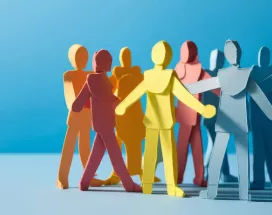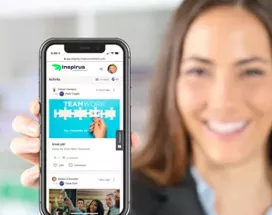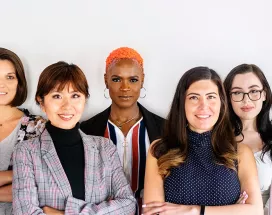Inspirus Blog
Welcome to our space where we celebrate the power of rewards, recognition, and robust employee engagement. Dive in to discover transformative solutions that elevate workplace culture, boost morale, and drive unparalleled performance. Let's embark on a journey to appreciate, motivate, and empower your most valuable asset: your people.

Employee Engagement
the widespread understanding among organizations of all kinds that the employee experience is directly related to, and has a significant impact on, the customer experience.... The term “employee experience” has become a very popular buzzword over the past several years. Do a quick Google search and you’ll come up with 7.8 billion results. Even putting the term in parentheses yields almost 2.5 million results.

Employee Engagement
By Lindsey Lyons
Trying to complete a project or task at work when feeling unwell, tired, stressed, or unhappy can be challenging. Those feelings can also disrupt team culture as they negatively affect how a person interacts with others. With the global pandemic in its second year, we are seeing more and more people struggling with these feelings. So, how do you address your employees' physical, mental, emotional, and social needs? Incorporating wellness into your employee engagement strategies and using an engagement platform like Inspirus® Connects, are two ways to accomplish this.

Employee Engagement
By Sean Mayo
The most successful organizations recognize the value of engaged employees and understand that engagement is driven to a large degree by recognition and rewards — not just from managers, but from peers, customers, and others. However, the challenge companies face is that the more they grow. The more challenging it becomes to recognize employees consistently and appropriately for the contributions they make. Employing the right employee engagement strategies can make a big difference.

Employee Engagement
By Kelly Briggs
The downtime during the pandemic shutdown of 2020, coupled with this past summer, gave us all a lot of time to catch up on our reading. We explored new books, re-read old favorites, and exchanged picks with our friends and co-workers, all with the purpose of enjoyment, enlightenment, and continuous learning.

Employee Engagement
By Kelly Briggs
It’s been a rough time for all of us since COVID-19 emerged and changed the work world forever. Just as employers thought they would be soon getting back to some semblance of normalcy, the Delta variant surfaced causing many to shutter or shift plans to call employees back to the workplace and attempts to go back to “business as usual.” Many have accepted the likely reality that business will never be back to usual — business leaders will need to learn to navigate, lead, and inspire in a workplace where some employees (and managers) will be on site and others will be working remotely.

Employee Retention
By Kelley Briggs
Diversity and inclusion are at the forefront of all kinds of business conversations these days. In fact, it would be more accurate to say that diversity, equity, and inclusion are key considerations impacting organizations ranging from retailers to manufacturers and everything in between.... diversity, equity, and inclusion efforts into nine key focus areas. Here we take a look at how companies are doing this and the steps your organization can take to become more mindful about diversity, equity, and inclusion to drive business results. Shen recommends getting to the bottom of why inclusion hasn’t been more prominent in the past.

Employee Recognition
By Kelley Briggs
Peer-to-peer recognition from peers is a powerful way to build our relationships and tie together that social cohesion that everyone appreciates. Whether employees work from home, or at the company headquarters, they want to feel valued and respected by others around them.

Employee Recognition
By Patti Traglio
Things change. We have only to look back on the past several months of disruption related to the pandemic to understand how true this is. And, while change is usually not quite so sudden or severe, companies are always being impacted by changes that can make legacy systems no longer as effective as they may initially have been.

Culture
By Lesa Blakey
We’ve been hearing these labels for years: “Baby Boomers,” “Gen Xers” and so on. Ever since the concept of generational groups was developed in the early 90’s as a marketing tool to identify and understand potential customers, we’ve been grouping people into specific age brackets for many reasons. It’s generally believed that those who grew up under a similar time and circumstance often share similar attitudes and behaviors like work ethic, technological adaptation, worldviews, and opinions on authority (i.e., Boomers offer solid work principles, Gen Xers have great personal initiative, Millennials strive for cultural diversity, Gen Z are natural technology whizzes).

Employee Recognition
By Kelley Briggs
What makes an employee recognition communication plan succeed? What makes one fail? A successful employee recognition program is characterized by widespread adoption, employee engagement, and satisfaction. Conversely, the failure of such a program looks like spotty involvement, lack of buy-in, and lackluster response.

Culture
By Guest Contributor
If you want to take your business to the next level, one of the best ways to do it is to focus on your company’s culture. The culture at your business can have a positive impact on everything from work environment to productivity to employee morale.

Employee Engagement
By Kelly Briggs
With COVID-19 vaccines easing the many virus restrictions on our everyday lives, the time has finally come for many workers to return to the office. But although the transition back may be welcomed by some, many are having a challenging time with it.

Culture
By Terri Moore
These shifts are causing perspectives of C-suite leaders to change — from CHROs to the CEO.... Since the pandemic, helping employees has become more than just keeping workers safe. HR leadership — and C-suite leaders at large — recognize that they need to ensure that the overall employee experience is stronger and better than ever in order to keep their employees on board and productive.

Employee Engagement
By Kelley Briggs
In recent years, it has become evident that creating a company culture that encourages employee engagement does more than simply keep your workers content. According to Gallup, a highly engaged business unit is 21% more profitable than your average company and receives 10% more approval... in customer ratings. It follows then that engagement will not only be a major focal point in 2021, but it will assume a deeper meaning, a way for organizations to attract and retain the best talent... Techniques for Employee Rewards and Recognition to consider.

Culture
By Kelley Briggs
In an inclusive workplace, everyone feels respected and valued for being who they are; people trust that they can speak up, do their best at work, and be treated fairly. People who are happy in the workplace are more likely to perform better and contribute more to business success. The proof? Deloitte’s research shows when employees think their organization is committed to and supportive of diversity, and they feel included, their ability to innovate increases by 83%. McKinsey & Company reports companies with strong gender and ethnic diversity are 15% and 35%, respectively, more likely to outperform their competitors.